Creative mentorship programs play a crucial role in fostering talent by offering personalized support and industry insights that facilitate personal and professional growth. By connecting participants with a diverse range of mentors, these programs provide structured guidance that enhances creative skills and expands professional networks. Successful alumni often leverage their experiences and newfound confidence to thrive in their careers, showcasing the lasting impact of effective mentorship.
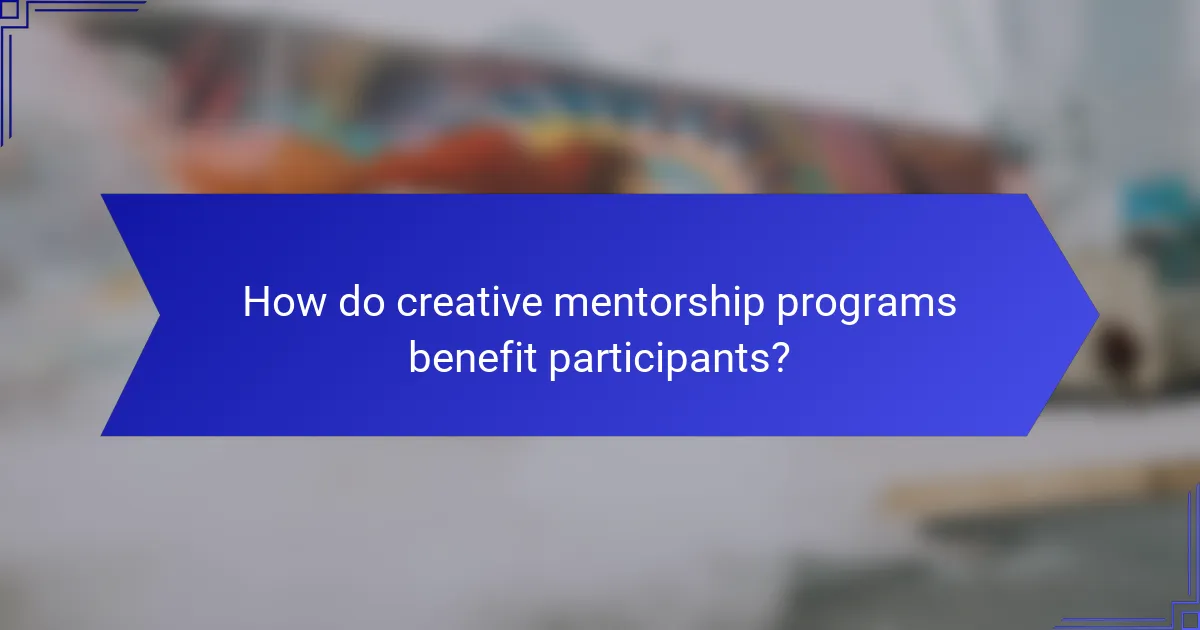
How do creative mentorship programs benefit participants?
Creative mentorship programs provide participants with tailored support, valuable industry insights, and opportunities for personal growth. These programs help individuals enhance their skills, expand their professional networks, and boost their confidence in creative endeavors.
Skill development through personalized guidance
Participants in creative mentorship programs receive customized instruction that targets their specific needs and goals. This personalized approach allows mentees to focus on areas where they seek improvement, whether it’s mastering a new technique or refining their artistic voice.
For example, a graphic design mentee might work closely with a mentor to develop proficiency in software tools, while a writer could receive feedback on narrative structure. This hands-on guidance accelerates skill acquisition and fosters a deeper understanding of the creative process.
Networking opportunities with industry leaders
Creative mentorship programs often connect participants with established professionals in their fields, opening doors to valuable networking opportunities. Engaging with industry leaders can lead to collaborations, job offers, or introductions to other influential contacts.
For instance, a filmmaker might meet producers or distributors through their mentor, significantly enhancing their chances of getting projects funded or distributed. Building these connections is crucial for long-term success in creative industries.
Increased confidence and creative output
Through constructive feedback and encouragement from mentors, participants often experience a boost in confidence that translates into greater creative output. This newfound assurance allows individuals to take risks in their work, experiment with new ideas, and push their artistic boundaries.
As a result, many mentees report producing a higher volume of work and exploring diverse styles. This increase in creative output not only enriches their portfolios but also enhances their overall artistic identity.

What are the key features of successful creative mentorship programs?
Successful creative mentorship programs typically include a structured approach and access to a diverse range of mentors. These features ensure that participants receive targeted guidance and exposure to various perspectives, enhancing their creative development.
Structured curriculum with measurable outcomes
A structured curriculum is essential for effective mentorship programs, as it provides a clear framework for learning and development. This curriculum should outline specific goals, activities, and timelines, allowing participants to track their progress and achievements.
Measurable outcomes can include completed projects, skill assessments, or feedback sessions. For instance, a program might require participants to submit a portfolio piece every few months, demonstrating their growth and understanding of key concepts.
Access to diverse mentors across various fields
Access to a variety of mentors is crucial for broadening participants’ perspectives and skills. Mentors from different creative fields—such as design, writing, and multimedia—can offer unique insights and techniques that enrich the learning experience.
Programs should aim to connect participants with mentors who have diverse backgrounds and expertise. This could involve organizing networking events, workshops, or panel discussions where mentees can interact with professionals from various industries, fostering a rich exchange of ideas and experiences.
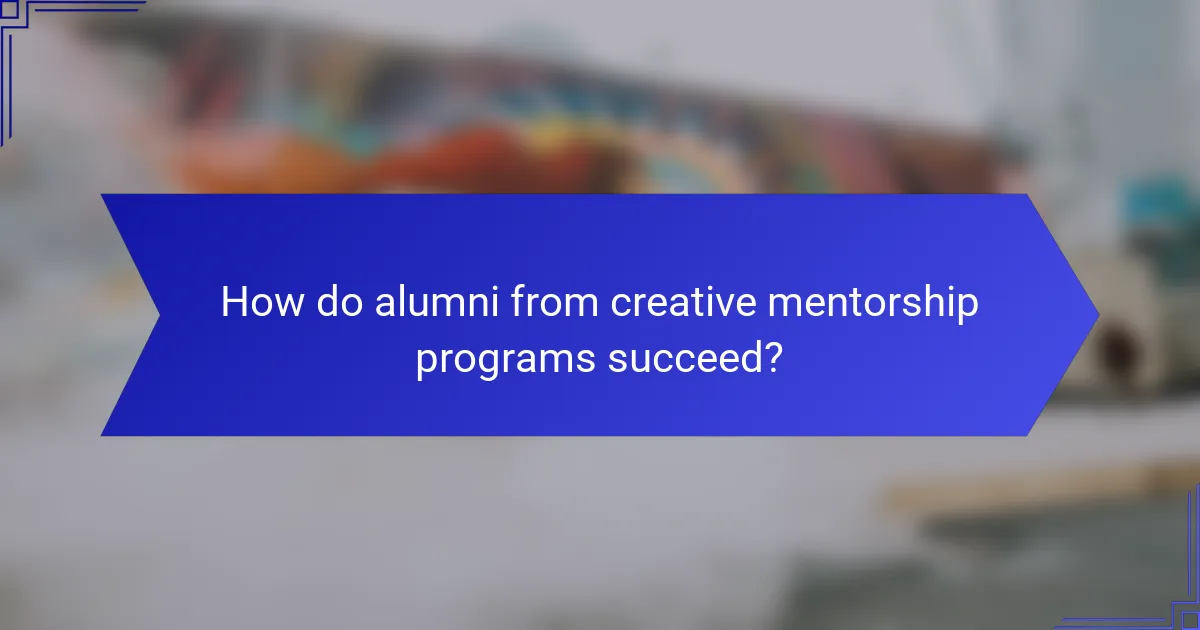
How do alumni from creative mentorship programs succeed?
Alumni from creative mentorship programs often succeed by leveraging the skills and networks gained during their mentorship. They apply real-world experiences and enhanced portfolios to secure opportunities in their respective fields.
Real-world project experience
Participants in creative mentorship programs typically engage in hands-on projects that mimic industry standards. This practical experience allows them to develop crucial skills and understand the dynamics of working in a professional environment.
For instance, a graphic design mentee might collaborate with a local business to create branding materials, providing them with a tangible project to showcase in their portfolio. Such experiences not only build confidence but also enhance problem-solving abilities in real-time scenarios.
Portfolio enhancement through mentorship
Mentorship programs often emphasize the importance of a strong portfolio, which serves as a critical tool for job applications. Alumni frequently receive guidance on how to curate their work effectively, highlighting their best projects and skills.
By incorporating feedback from mentors, alumni can refine their portfolios to meet industry expectations. A well-structured portfolio can significantly increase the chances of landing interviews, as it demonstrates both creativity and professionalism.
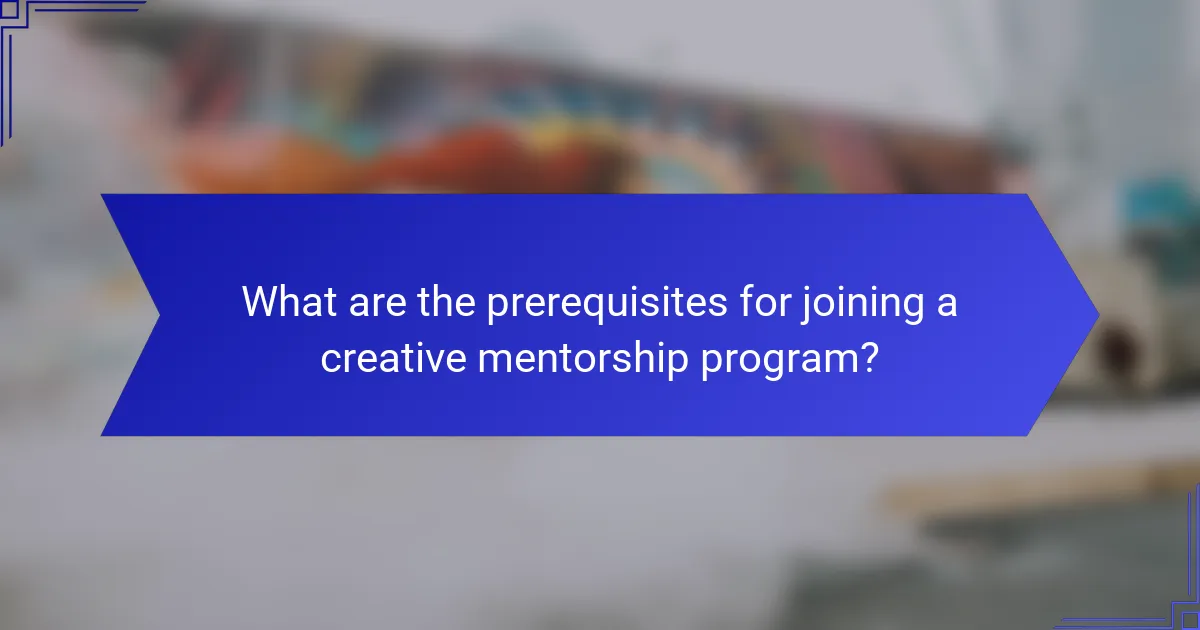
What are the prerequisites for joining a creative mentorship program?
Prerequisites for joining a creative mentorship program typically include a passion for the creative field, a willingness to learn, and a commitment to personal growth. Many programs also require applicants to have a basic understanding of their chosen discipline, which can vary by program.
Application process and eligibility criteria
The application process for creative mentorship programs usually involves submitting an application form, a portfolio of work, and sometimes a personal statement. Eligibility criteria can vary widely, but many programs target emerging creatives, often with age limits or specific educational backgrounds.
Common requirements include being a student or recent graduate in a related field, such as art, design, writing, or music. Some programs may also look for prior experience or specific achievements, like awards or recognitions, to assess an applicant’s potential.
Required skills and background knowledge
Applicants should possess foundational skills relevant to their creative discipline. For example, aspiring graphic designers should have a grasp of design software, while writers might need strong writing and editing skills. Background knowledge in art history or contemporary trends can also be beneficial.
Additionally, soft skills such as communication, collaboration, and adaptability are crucial. Many mentorship programs emphasize the importance of being open to feedback and willing to engage in constructive criticism, as these traits can significantly enhance the mentorship experience.

How do creative mentorship programs compare in different regions?
Creative mentorship programs vary significantly across regions, influenced by local culture, funding, and industry needs. In the US, these programs often emphasize networking and career advancement, while European programs may focus more on collaborative projects and artistic development.
Program availability in major US cities
In major US cities like New York, Los Angeles, and Chicago, creative mentorship programs are widely available and often supported by local arts organizations or universities. These programs typically offer structured mentorship relationships, workshops, and networking events that cater to various creative fields, including visual arts, music, and writing.
For example, programs in New York often feature high-profile mentors from the industry, while Los Angeles may provide access to professionals in film and entertainment. Participants can expect to invest time ranging from a few weeks to several months, depending on the program’s depth and focus.
Differences in program structure across Europe
European creative mentorship programs tend to differ in structure, often emphasizing collaboration and community engagement. Many programs are supported by government grants or cultural institutions, which can lead to a more diverse range of participants and mentors.
For instance, programs in countries like Germany and Sweden may include group projects and public exhibitions as part of the mentorship experience, fostering a sense of community among participants. Additionally, these programs might last from several months to a year, allowing for deeper exploration and development of creative skills.

What are the emerging trends in creative mentorship?
Emerging trends in creative mentorship include the rise of virtual platforms and a strong emphasis on diversity and inclusion. These trends reflect the evolving landscape of mentorship, making it more accessible and equitable for a wider range of participants.
Virtual mentorship and online platforms
Virtual mentorship leverages online platforms to connect mentors and mentees regardless of geographical barriers. This format allows for flexible scheduling and a broader selection of mentors, which can enhance the learning experience.
Popular platforms such as Zoom, Slack, and specialized mentorship apps facilitate communication and resource sharing. When choosing a platform, consider user-friendliness, features like video conferencing, and the ability to share documents easily.
Focus on diversity and inclusion in mentorship
There is a growing recognition of the importance of diversity and inclusion in creative mentorship programs. This focus ensures that individuals from various backgrounds and experiences can participate, enriching the mentorship process for everyone involved.
To implement inclusive practices, programs should actively recruit mentors and mentees from underrepresented groups. Additionally, creating a safe space for open dialogue and feedback can foster a more supportive environment.
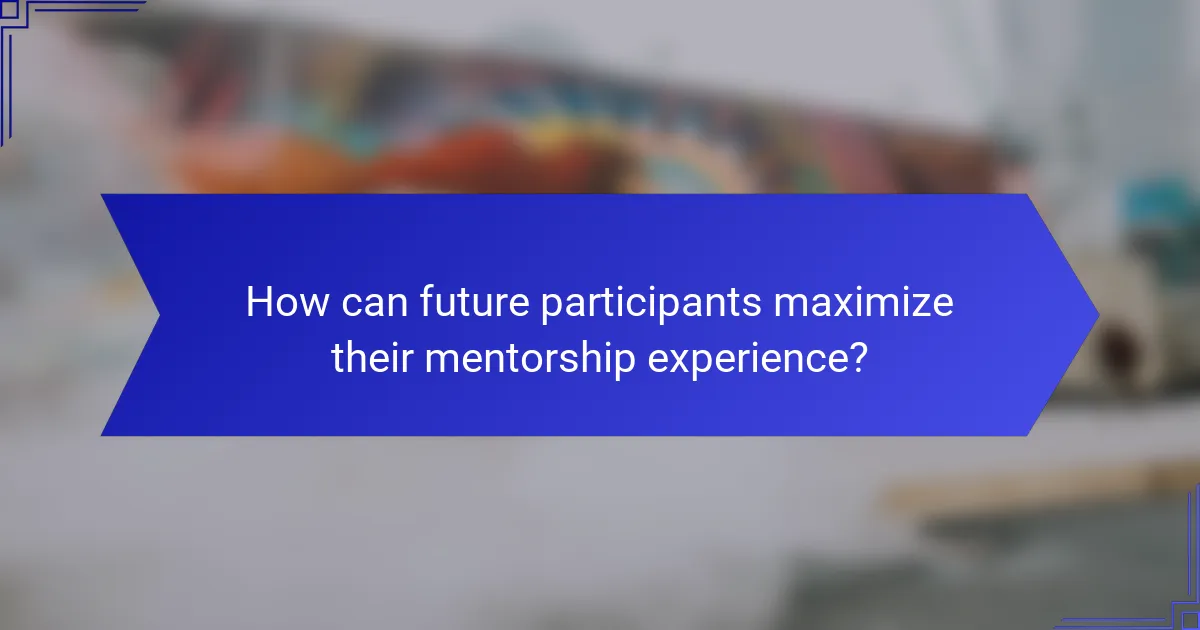
How can future participants maximize their mentorship experience?
Future participants can maximize their mentorship experience by being proactive and intentional in their approach. Establishing clear goals and engaging actively with mentors are key strategies for making the most of the mentorship opportunity.
Setting clear goals and expectations
Setting clear goals and expectations is crucial for a successful mentorship experience. Participants should define what they hope to achieve, whether it’s gaining specific skills, expanding their network, or receiving guidance on career decisions. Writing these goals down can help clarify intentions and provide a reference point throughout the mentorship.
It’s beneficial to communicate these goals with the mentor early on. This ensures both parties are aligned and can work together effectively. Regularly revisiting and adjusting these goals based on progress can also enhance the mentorship relationship.
Engaging actively with mentors
Active engagement with mentors is essential for a fruitful mentorship experience. Participants should come prepared to meetings with questions, updates on their progress, and topics for discussion. This not only shows respect for the mentor’s time but also fosters a more dynamic and productive dialogue.
Additionally, following up on advice given and implementing suggestions can demonstrate commitment and initiative. Participants should also be open to feedback, as it can provide valuable insights for personal and professional growth. Regular communication, whether through emails or scheduled check-ins, helps maintain momentum in the mentorship relationship.
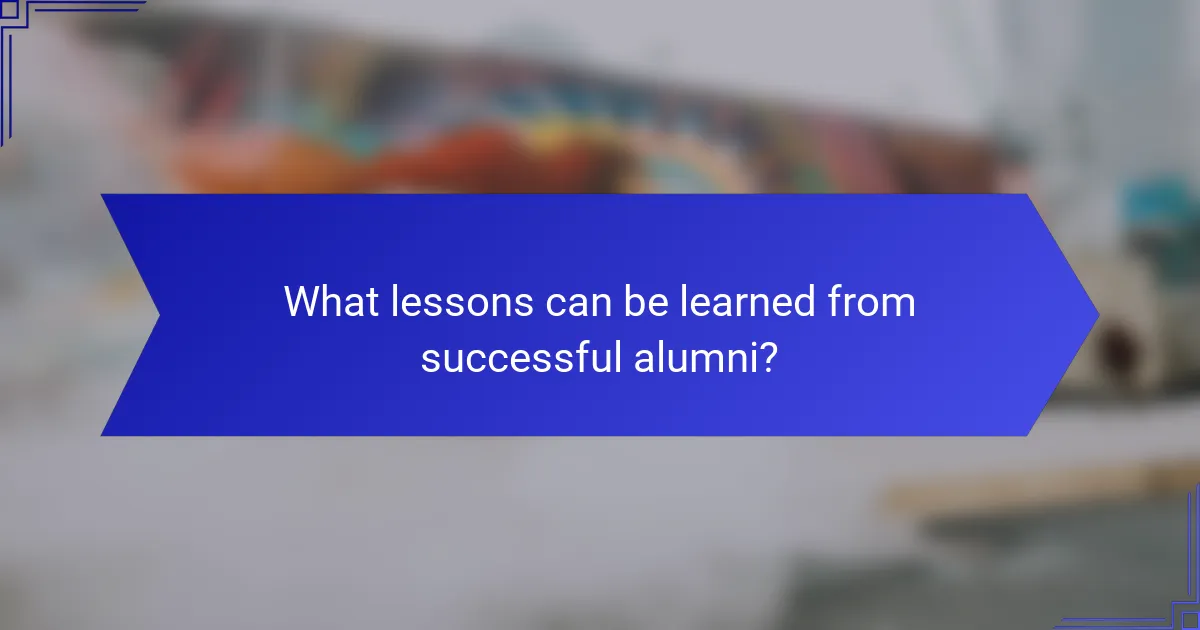
What lessons can be learned from successful alumni?
Successful alumni from creative mentorship programs often emphasize the importance of networking, adaptability, and continuous learning. These lessons highlight how building relationships and being open to change can significantly impact one’s creative journey.
Networking and Relationship Building
Networking is a crucial lesson learned by many alumni. Establishing connections with peers, mentors, and industry professionals can open doors to new opportunities and collaborations. Engaging in community events, workshops, and online forums can enhance visibility and foster valuable relationships.
To effectively network, consider attending local creative meetups or joining relevant online groups. Aim to connect with at least one new person at each event, and follow up with them afterward to maintain the relationship.
Embracing Adaptability
Successful alumni often highlight the need for adaptability in their creative pursuits. The ability to pivot in response to feedback or changing trends can lead to innovative outcomes. Being flexible allows creatives to explore new ideas and refine their work based on real-world experiences.
To cultivate adaptability, regularly seek constructive criticism and be willing to experiment with different styles or mediums. This approach can help you stay relevant and inspired in a rapidly evolving creative landscape.
Commitment to Continuous Learning
Continuous learning is a fundamental lesson from alumni experiences. The creative field is always evolving, and staying updated with new techniques, tools, and industry trends is essential. Engaging in workshops, online courses, or reading relevant literature can enhance skills and broaden perspectives.
Set aside time each week for learning, whether through formal education or self-directed study. Aim to master at least one new skill per quarter, which can significantly boost your creative capabilities over time.